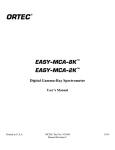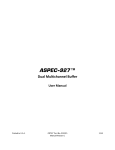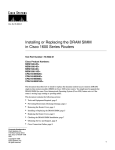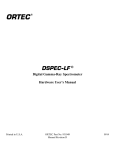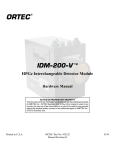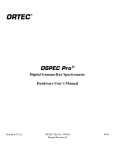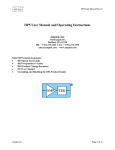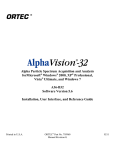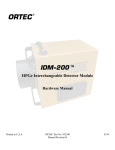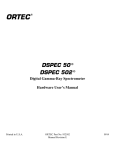Download C:\Software Manuals (Keyser)\783530E TRUMP-PCI.wpd
Transcript
69;,*
®
TRUMP®-PCI-8K
TRUMP®-PCI-2K
Multichannel Buffer Card
Hardware Manual
Printed in U.S.A.
ORTEC Part No. 783530
Manual Revision E
4314 0502
$GYDQFHG 0HDVXUHPHQW 7HFKQRORJ\ ,QF
a/k/a/ ORTEC®, a subsidiary of AMETEK®, Inc.
WARRANTY
ORTEC* warrants that the items will be delivered free from defects in material or workmanship. ORTEC makes no other
warranties, express or implied, and specifically NO WARRANTY OF MERCHANTABILITY OR FITNESS FOR A
PARTICULAR PURPOSE.
ORTEC’s exclusive liability is limited to repairing or replacing at ORTEC’s option, items found by ORTEC to be defective
in workmanship or materials within one year from the date of delivery. ORTEC’s liability on any claim of any kind, including
negligence, loss, or damages arising out of, connected with, or from the performance or breach thereof, or from the
manufacture, sale, delivery, resale, repair, or use of any item or services covered by this agreement or purchase order, shall in
no case exceed the price allocable to the item or service furnished or any part thereof that gives rise to the claim. In the event
ORTEC fails to manufacture or deliver items called for in this agreement or purchase order, ORTEC’s exclusive liability and
buyer’s exclusive remedy shall be release of the buyer from the obligation to pay the purchase price. In no event shall
ORTEC be liable for special or consequential damages.
Quality Control
Before being approved for shipment, each ORTEC instrument must pass a stringent set of quality control tests designed to expose
any flaws in materials or workmanship. Permanent records of these tests are maintained for use in warranty repair and as a source
of statistical information for design improvements.
Repair Service
If it becomes necessary to return this instrument for repair, it is essential that Customer Services be contacted in advance of its
return so that a Return Authorization Number can be assigned to the unit. Also, ORTEC must be informed, either in writing, by
telephone [(865) 482-4411] or by facsimile transmission [(865) 483-2133], of the nature of the fault of the instrument being
returned and of the model, serial, and revision ("Rev" on rear panel) numbers. Failure to do so may cause unnecessary delays in
getting the unit repaired. The ORTEC standard procedure requires that instruments returned for repair pass the same quality
control tests that are used for new-production instruments. Instruments that are returned should be packed so that they will
withstand normal transit handling and must be shipped PREPAID via Air Parcel Post or United Parcel Service to the designated
ORTEC repair center. The address label and the package should include the Return Authorization Number assigned. Instruments
being returned that are damaged in transit due to inadequate packing will be repaired at the sender's expense, and it will be the
sender's responsibility to make claim with the shipper. Instruments not in warranty should follow the same procedure and ORTEC
will provide a quotation.
Damage in Transit
Shipments should be examined immediately upon receipt for evidence of external or concealed damage. The carrier making
delivery should be notified immediately of any such damage, since the carrier is normally liable for damage in shipment. Packing
materials, waybills, and other such documentation should be preserved in order to establish claims. After such notification to the
carrier, please notify ORTEC of the circumstances so that assistance can be provided in making damage claims and in providing
replacement equipment, if necessary.
Copyright © 2002, Advanced Measurement Technology, Inc. All rights reserved.
*ORTEC® is a registered trademark of Advanced Measurement Technology, Inc. All other trademarks used herein are the
property of their respective owners.
TABLE OF CONTENTS
Safety Instructions and Symbols . . . . . . . . . . . . . . . . . . . . . . . . . . . . . . . . . . . . . . . . . . . . . . . . iv
Cleaning Instructions . . . . . . . . . . . . . . . . . . . . . . . . . . . . . . . . . . . . . . . . . . . . . . . . . . . . . . . . . iv
1. INTRODUCTION . . . . . . . . . . . . . . . . . . . . . . . . . . . . . . . . . . . . . . . . . . . . . . . . . . . . . . . . . 1
1.1. Using the Manual . . . . . . . . . . . . . . . . . . . . . . . . . . . . . . . . . . . . . . . . . . . . . . . . . . . . . . 1
2. SPECIFICATIONS . . . . . . . . . . . . . . . . . . . . . . . . . . . . . . . . . . . . . . . . . . . . . . . . . . . . . . . . 3
2.1. Performance . . . . . . . . . . . . . . . . . . . . . . . . . . . . . . . . . . . . . . . . . . . . . . . . . . . . . . . . . . 3
2.2. Controls . . . . . . . . . . . . . . . . . . . . . . . . . . . . . . . . . . . . . . . . . . . . . . . . . . . . . . . . . . . . . 4
2.3. Inputs . . . . . . . . . . . . . . . . . . . . . . . . . . . . . . . . . . . . . . . . . . . . . . . . . . . . . . . . . . . . . . . 4
2.4. Electrical and Mechanical . . . . . . . . . . . . . . . . . . . . . . . . . . . . . . . . . . . . . . . . . . . . . . . 4
2.5. Software Prerequisites . . . . . . . . . . . . . . . . . . . . . . . . . . . . . . . . . . . . . . . . . . . . . . . . . . 4
3. INSTALLATION . . . . . . . . . . . . . . . . . . . . . . . . . . . . . . . . . . . . . . . . . . . . . . . . . . . . . . . . . . 5
3.1. Live-Time Mode . . . . . . . . . . . . . . . . . . . . . . . . . . . . . . . . . . . . . . . . . . . . . . . . . . . . . . 5
3.2. Installing the TRUMP-PCI Card . . . . . . . . . . . . . . . . . . . . . . . . . . . . . . . . . . . . . . . . . . 6
3.3. Setting Up a Multiple-MCB System . . . . . . . . . . . . . . . . . . . . . . . . . . . . . . . . . . . . . . . . 6
3.4. Cabling a System . . . . . . . . . . . . . . . . . . . . . . . . . . . . . . . . . . . . . . . . . . . . . . . . . . . . . . 6
3.5. Adjusting the Lower- and Upper-Level Discriminators . . . . . . . . . . . . . . . . . . . . . . . . . . 7
3.6. Setting the Zero Adjustment . . . . . . . . . . . . . . . . . . . . . . . . . . . . . . . . . . . . . . . . . . . . . . 8
3.7. Enabling the Gate Input . . . . . . . . . . . . . . . . . . . . . . . . . . . . . . . . . . . . . . . . . . . . . . . . . 8
3.8. Troubleshooting . . . . . . . . . . . . . . . . . . . . . . . . . . . . . . . . . . . . . . . . . . . . . . . . . . . . . . . 8
4. MCA BASICS . . . . . . . . . . . . . . . . . . . . . . . . . . . . . . . . . . . . . . . . . . . . . . . . . . . . . . . . . . . . 9
4.1. MCB Operation . . . . . . . . . . . . . . . . . . . . . . . . . . . . . . . . . . . . . . . . . . . . . . . . . . . . . . . 9
4.2. Dead Time in MCA and Amplifier . . . . . . . . . . . . . . . . . . . . . . . . . . . . . . . . . . . . . . . . 10
5. COMMANDS AND RESPONSES . . . . . . . . . . . . . . . . . . . . . . . . . . . . . . . . . . . . . . . . . . .
5.1. Command Records . . . . . . . . . . . . . . . . . . . . . . . . . . . . . . . . . . . . . . . . . . . . . . . . . . . .
5.2. Percent Response Records . . . . . . . . . . . . . . . . . . . . . . . . . . . . . . . . . . . . . . . . . . . . . .
5.3. Dollar Response Records . . . . . . . . . . . . . . . . . . . . . . . . . . . . . . . . . . . . . . . . . . . . . . .
5.4. Command Catalog . . . . . . . . . . . . . . . . . . . . . . . . . . . . . . . . . . . . . . . . . . . . . . . . . . . .
13
13
14
15
16
APPENDIX A. GLOSSARY . . . . . . . . . . . . . . . . . . . . . . . . . . . . . . . . . . . . . . . . . . . . . . . . . . 35
INDEX . . . . . . . . . . . . . . . . . . . . . . . . . . . . . . . . . . . . . . . . . . . . . . . . . . . . . . . . . . . . . . . . . . . 37
iii
Safety Instructions and Symbols
This manual contains up to three levels of safety instructions that must be observed in order to
avoid personal injury and/or damage to equipment or other property. These are:
DANGER
Indicates a hazard that could result in death or serious bodily harm if the safety
instruction is not observed.
WARNING Indicates a hazard that could result in bodily harm if the safety instruction is not
observed.
CAUTION
Indicates a hazard that could result in property damage if the safety instruction is not
observed.
In addition, the following symbols may appear on the product:
DANGER–High Voltage
ATTENTION–Refer to Manual
Please read all safety instructions carefully and make sure you understand them fully before
attempting to use this product.
Cleaning Instructions
To clean the instrument exterior:
Disconnect the instrument from the power source.
Remove loose dust on the outside of the instrument with a lint-free cloth.
Remove remaining dirt with a lint-free cloth dampened in a general-purpose detergent and
water solution. Do not use abrasive cleaners.
CAUTION To prevent moisture inside of the instrument during external cleaning, use only
enough liquid to dampen the cloth or applicator.
Allow the instrument to dry completely before reconnecting it to the power source.
iv
1. INTRODUCTION
The ORTEC TRUMP-PCI Multichannel Analyzer (MCA) brings our TRUMP multichannel buffer
card into PCI format, giving you a computer-controlled multichannel pulse-height analyzer for
high-performance data acquisition in nuclear spectroscopy applications.
The TRUMP-PCI-8K/-2K consists of a single-slot PCI card and the MAESTRO®-32 MCA
Emulation Software for Microsoft® Windows 95, Windows 98, and Windows NT®.
Up to eight TRUMP-PCI cards can be controlled from the same PC under one copy of
MAESTRO-32 with no overhead on the PC resources. During data acquisition the computer is
entirely free to run other tasks.
A large number of ORTEC software applications support the TRUMP-PCI, and developer’s
toolkits are also available.
1.1. Using the Manual
This manual discusses the initial setup and installation of the TRUMP-PCI-8K/-2K card. For
instructions on installing and operating MAESTRO-32, refer to the MAESTRO-32 Software
User’s Manual.
Chapter 1 of this manual gives a brief description of the TRUMP-PCI/MAESTRO-32 system.
Chapter 2 gives the TRUMP-PCI card specifications. Chapter 3 tells how to set up and install the
TRUMP-PCI card. Chapter 4 describes the basics of MCA operation. Chapter 5 explains the
commands used to control the system for users who wish to write custom software to control the
TRUMP-PCI card.
1
TRUMP®-PCI 8K/2K Multichannel Buffer Card
2
2. SPECIFICATIONS
2.1. Performance
ADC Successive-approximation type with sliding scale linearization.
Resolution Software selectable as 512, 1024, and 2048 for the TRUMP-PCI-2K, with addition
choices of 4096 and 8192 for the TRUMP-PCI-8K.
Dead Time Per Event 9 s, including memory transfer. Use the SET_RESET_DELAY and
SHOW_RESET DELAY commands to decrease (to a minimum of 8 s) or increase system dead
time (see Section 5.4).
Integral Nonlinearity
±0.025% over the top 99% of the dynamic range.
Differential Nonlinearity <±1% over the top 99% of the dynamic range.
Gain Instability
±50 ppm/°C.
Dead-Time Correction Printed wiring board jumper selects either extended live-time correction
according to the Gedcke-Hale1 method, or simple live-time correction with the clock turned off
during the conversion time.
Data Memory 8K channels of battery backed-up memory; 2311 counts per channel (over 2
billion).
Presets
Real Time/Live Time: Multiples of 20 ms.
Region of Interest: Peak count/Integral count.
Data Overflow: Terminates acquisition when any channel exceeds 2311.
Peak Uncertainty::Stops acquisition when the statistical or counting uncertainty of a userselected net peak reaches the specified value.
Nuclide MDA: Stops data collection when the value of the Minimum Detectable Activity
(MDA) for a user-specified MDA nuclide reaches the specified value.
Microprocessor Intel 386; 32K × 16 RAM with battery backup; 4-Mbit flash memory.
1
Ron Jenkins, R.W. Gould, and Dale Gedcke, Quantitative X-Ray Spectrometry (New York: Marcel Dekker,
Inc.), 1981, pp 266267.
3
TRUMP®-PCI 8K/2K Multichannel Buffer Card
2.2. Controls
ADC Zero Computer controlled, ±125 mV.
ADC LLD Computer controlled, from 0 to 100% full scale.
ADC ULD Computer controlled, from 0 to 100% full scale.
2.3. Inputs
IN (Input) Accepts positive unipolar, positive gated integrator, or positive leading bipolar analog
pulses in the dynamic range from 0 to +10 V; +12 V maximum; semi-Gaussian- shaped or
gated-integrator-shaped time constants from 0.25 to 30 s, or delay-line-shaped with width
>0.25 s. Zin 1 k6, dc-coupled. No internal delay. BNC connector on rear panel.
GATE (ADC gate) Optional, slow-positive NIM input. Computer-selectable coincidence or
anticoincidence. Signal must occur prior to and extend 0.5 s beyond the peak of the pulse;
rear-panel BNC connector. Zin 1 k6.
PUR Pile-up rejection input; accepts slow-positive NIM signal; signal must occur prior to peak
detect. Zin 1 k6. BNC connector on rear panel.
BUSY Busy input used by live-time correction circuits. Accepts slow-positive NIM signal;
signal must occur prior to peak detect. Zin 1 k6. BNC connector on rear panel.
2.4. Electrical and Mechanical
Power Required +5 V, 1.5 A.
Dimensions Standard full-slot PCI card.
2.5. Software Prerequisites
MAESTRO-32 runs on any PC that supports Windows 95, Window 98, or Windows NT.
4
3. INSTALLATION
This chapter tells how to set up a standard TRUMP-PCI system. Section 3.1 shows how to select
extended or simple live-time correction mode. Section 3.2 describes how to install the
TRUMP-PCI card. Section 3.3 discusses multiple-MCB systems. Section 3.4 contains the cabling
requirements for a standard detector system. Sections 3.5 and 3.6 tell how to adjust the lower- and
upper-level discriminators and the zero adjustment. Section 3.7 describes the Gate Input. Section
3.8 contains troubleshooting information.
3.1. Live-Time Mode
The TRUMP-PCI card has two different live-time correction modes; extended and simple. The
extended mode is the Gedcke-Hale correction mode which corrects for losses caused by pile-up in
the shaping amplifier. This is the default setting and is usually the correct setting for energy
spectroscopy systems. The simple live-time correction mode simply stops the live-time clock when
the BUSY signal is active, the TRUMP-PCI card detects that a pulse is arriving at its input, or the
TRUMP-PCI card is busy digitizing data. The simple live-time mode is appropriate only in very
specialized situations and is not the correct setting for most users.
Figure 1 shows the location of the live-time correction mode jumper J7. Remove the jumper for
extended live-time correction, or leave it on for simple live-time correction.
Figure 1. TRUMP-PCI Jumper Settings and Backup Battery.
5
TRUMP®-PCI 8K/2K Multichannel Buffer Card
3.2. Installing the TRUMP-PCI Card
CAUTION Always turn the PC off and unplug it from the mains power supply before
installing a card.
1. Remove the PC cover.
2. Remove the slot cover from an unused PCI slot.
3. Insert the card at an angle to get the BNC connectors through the opening on the rear of the
PC, then press the card gently and firmly into the slot connector.
4. Fasten the card to the chassis with the option slot cover screw.
5. Replace the computer cover.
6. The TRUMP-PCI card uses a driver for communication with Windows. The driver file is
supplied on floppy disk. To install the driver in Windows 95/98, install the card, restart the PC,
and allow Windows to autodetect the new hardware. When Windows asks for the driver,
browse the floppy disk for the file PCITrump.ini via a label, and click on OK. In
Windows NT and when autodetect does not work, use Start, Settings, Control Panel, Add
New Hardware to install the driver.
3.3. Setting Up a Multiple-MCB System
Up to eight ORTEC MCBs, in any combination, can be attached at one time to a single PC. To
prevent conflicts in multiple-MCB systems, each MCB must be assigned a unique hardware
address. This is done automatically in TRUMP-PCI cards so there are no jumpers or DIP switches
for you to set. However, other types of MCBs may still require you to set jumpers or DIP
switches; follow the instructions in the corresponding hardware manuals.
3.4. Cabling a System
The standard cabling of a TRUMP-PCI card in a HPGe detector system is shown in Fig. 2. If the
detector has a TRP preamplifier (“-PLUS” model), all connections shown should be made. If the
preamplifier is a resistive-feedback preamplifier, the INHIBIT OUTPUT does not exist, so the
connection to INHIBIT is not made (INHIBIT is left open).
6
3. INSTALLATION
Figure 2. HPGe System Cabling.
3.5. Adjusting the Lower- and Upper-Level Discriminators
The lower-level discriminator (LLD) and upper-level discriminator (ULD) are set in MAESTRO
with the ADC Setup... function under the Acquire menu. The LLD adjustment is used to prevent
small noise pulses from being converted by the ADC. Converting the noise pulses causes the ADC
to incur a large amount of dead time, which prevents the ADC from converting the actual pulses of
interest.
When the TRUMP-PCI card is shipped from the factory, the LLD is set at 40 channels, and the
ULD setting is 8000 channels. These are adequate for most systems.
If the system has high noise or there is a very low energy peak in the spectrum, it may be
advantageous to adjust the LLD setting. In the high-noise system, start collecting data and observe
the dead time on the screen along with the number of counts arriving at the low end of the
spectrum. In MAESTRO, increase the LLD setting until the dead time drops or the peaks due to
noise at the low end of the spectrum stop getting new counts.
7
TRUMP®-PCI 8K/2K Multichannel Buffer Card
If there is a low-energy peak in the spectrum, it may be necessary to lower the LLD setting to
prevent the peak from being rejected. Start data acquisition and observe the low end of the
spectrum while decreasing the LLD setting. Continue the adjustment until the peak is in the
spectrum. If the dead time goes to 100%, increase the LLD setting.
3.6. Setting the Zero Adjustment
The zero adjustment adds or subtracts a dc level from the input signal. Set the zero adjustment in
MAESTRO with the ADC Setup... function under the Acquire menu. Usually no zero adjustment
is required or recommended since most modern spectroscopy amplifiers have very little dc offset.
3.7. Enabling the Gate Input
The GATE connector operates in one of three modes:
Off — the Gate Input does nothing.
Coincident — for a pulse to be converted, the Gate Input must be active (>2.5 V) when the
pulse reaches its peak and for 0.5 s thereafter.
Anticoincident — for a pulse to be converted, the Gate Input must be inactive (<0.8 V) when
the pulse reaches its peak and for 0.5 s thereafter.
When the TRUMP-PCI card is shipped from the factory, the Gate Input is set Off. To change the
setting, use Acquire/ADC Setup... in MAESTRO.
3.8. Troubleshooting
Battery Backup FailedThe memory in the TRUMP-PCI has battery backup to maintain data
when power is turned off. The battery is a lithium battery with a nominal voltage of 3 V.
The battery is located on the top left corner of the TRUMP-PCI card (see Fig. 1). It may be
necessary to bend the battery holder down after removing the old battery to get good contact with
the new battery.
Battery Specification:
Type Lithium Coin Cell
Model Panasonic CR-2354
ORTEC Part Number 739480
8
4. MCA BASICS
This chapter contains some basic information about MCAs. ORTEC has taken the classical MCA
and partitioned it into two components: an MCB and a PC. The MCB contains the circuitry
required to create a spectrum while the personal computer is used for display of the spectrum and
control of the instrument. The first half of this section describes the circuitry found on the
TRUMP-PCI MCB, while the second half describes the dead-time effects encountered in an
MCA.
4.1. MCB Operation
This section contains a very basic description of the input circuitry and the chain of events that
occurs in the TRUMP-PCI card when an input pulse arrives to be histogrammed. Figure 3 shows
the basic block diagram of the input section of the TRUMP-PCI MCB. First a description of each
block in the circuit:
Figure 3. TRUMP-PCI Input Block Diagram.
Buffer — The buffer is provided to properly match impedances between the input and the
TRUMP-PCI circuitry.
Linear Gate — The linear gate protects the peak stretcher during conversion of an event.
When the linear gate is “open,” its output is identical to its input. When the linear gate is
“closed,” its output is always zero.
Peak Stretcher — The peak stretcher operates in one of two modes: Track or Hold. In Track
mode, the output of the peak stretcher is identical to its input. In Hold mode, the peak stretcher
acts like a maximum function. It outputs the maximum value which is applied to the input. The
peak stretcher also has a peak-detect output which goes active when its output is greater than
the value at its input.
9
TRUMP®-PCI 8K/2K Multichannel Buffer Card
Analog-to-Digital Converter (ADC) — The ADC takes an analog signal and converts it to a
digital equivalent.
Zero-Level, Lower-Level, and Upper-Level Discriminators — These adjustments provide
three control signals that help control the conversion process. The zero-level discriminator
(ZLD) is active when the input signal is greater than half of the LLD setting. The LLD is active
when the input signal is greater than the LLD setting. The ULD is active when the input signal
is greater than the maximum possible ADC output.
ADC Control — This circuit accepts all of the various status signals and provides the control
signals required to complete a conversion.
Microprocessor — The microprocessor accepts the digital data and adds it to the spectrum.
When an input pulse arrives, the sequence of events is as follows:
(1) ZLD goes active when the input reaches half of the LLD setting.
(2) When ZLD goes active, the peak stretcher is switched to Hold mode.
(3) When peak detect goes active, LLD, PUR, GATE and ULD are sampled. If any of these
signals rejects the pulse, the peak stretcher is returned to Track mode. If the pulse is
accepted, the linear gate is closed and the ADC is given the convert signal.
(4) When the ADC is finished converting, the data is transferred to the microprocessor for
histogramming, the linear gate is opened and the peak stretcher is returned to Track mode.
4.2. Dead Time in MCA and Amplifier
When a detector, preamplifier, spectroscopy amplifier, and MCA are combined to form a
spectroscopy system, the dead times of the amplifier and the MCA are in series. The combination
of the amplifier-extending dead time followed by the MCA non-extending dead time TM yields a
throughput described by:
(1)
The rate of events arriving at the detector is ri, and ro is the rate of analyzed events in the MCA
spectrum. TW is the width of the amplifier pulse at the noise discriminator threshold (Fig. 4). TP is
the time from the start of the amplifier pulse to the point at which the MCA detects peak amplitude
10
4. MCA BASICS
Figure 4. The Sources of Dead Time with An Amplifier
and MCA.
and closes the linear gate. U[TM(TWTP)] is a unit step function that changes from 0 to 1 when
TM is greater than (TWTP). TM is the conversion time of the ADC and includes the time required
to transfer the data to the subsequent memory.
The TRUMP-PCI card Extended Live Timer uses the Gedcke-Hale method to correct for the
dead-time losses implied by Eq. 1. When the counts in a full-energy peak are divided by the live
time, the resulting counting rate is an accurate estimate of the true counting rate for that gammaray energy at the detector output. The Gedcke-Hale method uses the amplifier analog output,
Busy, and PUR (pile-up-reject) signals. The amplifier dead time is combined with the ADC
conversion and readout dead time to obtain the overall system dead time. For accurate live time,
the PUR and BUSY signals must be connected from the amplifier to the TRUMP-PCI card.
The Gedcke-Hale live-time clock works as follows:
Either the leading edge of the amplifier Busy signal or the crossing of the ADC LLD by the
ADC Input causes the live-time clock to start counting backwards.
The live-time clock is turned off by the ADC peak detect or by the amplifier PUR signal.
The live-time clock resumes counting forward after all of the following signal conditions are
satisfied:
The ADC conversion and readout is complete.
The ADC input has returned below the LLD threshold.
The PUR and BUSY signals have returned to the inactive state.
11
TRUMP®-PCI 8K/2K Multichannel Buffer Card
Turning off the live-time clock compensates for the probability of losing a second pulse during the
processing of the first pulse. Subtracting live time compensates for the probability of losing two
pulses when the second pulse distorts the amplitude of the first pulse.
12
5. COMMANDS AND RESPONSES
This chapter is intended for users who wish to write custom software to control the TRUMP-PCI
card. For more information, see the MAESTRO-32 Software User’s Manual or the ORTEC
Universal MCB Interface (UMCBI) Toolkit (A11-B32).
Communication with a TRUMP-PCI card consists of sending command records to the MCB and
receiving response records from the MCB. The records consist of a sequence of printable ASCII
characters followed by an ASCII carriage return. All commands eventually respond with a percent
response record (so named because it begins with an ASCII percent sign “%”) which signifies the
completion of the command. SHOW commands respond with a dollar response record (begins
with an ASCII dollar sign “$”) followed by a percent response record.
All characters up to the first carriage return or the end of the message are considered to be part of
a command to the MCB.
5.1. Command Records
TRUMP-PCI commands contain a command header which may be followed by numeric parameter
values. The header consists of a verb or a verb and noun separated by an underscore or a verb,
noun, and modifier, each separated by underscores. The verbs, nouns, and modifiers in the
command header are mnemonic words such as the verb ENABLE or the noun OVERFLOW that
relate to the function performed by the MCB when it executes the command. The first four letters
of any word will always be enough to uniquely identify the word when composing commands for
an MCB. For example, the command ENABLE_OVERFLOW_PRESET can be abbreviated to
ENAB_OVER_PRES.
Numeric parameters are unsigned integer numbers that follow the command header separated by
one or more spaces. Specific commands require up to three parameters, separated by commas,
which specify numeric quantities related to the operation of the MCB, such as live time or
conversion gain. The command SET_WINDOW 0,8192 has two parameters, 0 and 8192, which
set the window of interest to start at channel 0 and continue for 8192 channels.
Some parameters listed in the command dictionary are considered optional and are distinguished
from mandatory parameters by being surrounded by brackets in the command prototype line (e.g.,
SET_WINDOW [start,length]). Commands that have optional parameters may be sent to the
MCB without the optional parameters, in which case the behavior will be changed as explained in
the command description.
An optional checksum may be added to the end of any command sent to an MCB. The checksum
is a 1-byte unsigned integer sum of all of the characters in a command, treated as unsigned
integers, up to and including the comma or space(s) that separates the checksum from the
13
TRUMP®-PCI 8K/2K Multichannel Buffer Card
command. The checksum simply appears as an extra parameter added to the end of the command
parameter list. For commands that do not normally have parameters, the checksum appears as the
only parameter separated from the header by one or more spaces. All optional parameters must be
included in a command if a checksum is to be provided so that the checksum is not mistaken by
the MCB as a parameter. For example, the SET_WINDOW command must include the two
optional parameters, start and length, if the checksum is provided (e.g., SET_WINDOW
0,8192,159).
5.2. Percent Response Records
TRUMP-PCI cards respond to all commands with a percent response record that signifies the
completion of the command. Percent response records contain two error code numbers and a 1byte checksum as follows:
%aaabbbccc<CR>
where % represents the ASCII % character, aaa represents the macro error code, bbb represents
the micro error code, ccc represents the checksum and <CR> represents the ASCII carriage return
character signifying the end of the record. The macro error code represents the general class of
error with 0 meaning no error, and the micro error code represents the sub-class of error with 0
meaning no error. The following table lists all percent responses for a TRUMP-PCI.
Unconditional Success:
%000000069
No errors detected
START/STOP Warnings:
%000005074
%000006075
MCB already started or stopped
Preset already exceeded
Command Syntax Errors:
%129001082
%129002083
%129003084
%129004085
%129005086
%129006087
%129007088
%129132087
14
Invalid verb in command
Invalid noun in command
Invalid verb and noun in command
Invalid modifier in command
Invalid verb and modifier in command
Invalid noun and modifier in command
Invalid verb, noun, and modifier in command
Invalid command (verb, noun, and modifier valid, but not
together)
5. COMMANDS AND RESPONSES
Communication Errors:
%130128084
%130129085
Incorrect checksum (only if checksum provided)
Command record too long
Execution Errors:
%131128085
%131129086
%131130078
%131132080
%131135083
%131136084
Invalid 1st parameter
Invalid 2nd parameter
Invalid 3rd parameter
Invalid number of parameters
Illegal command while acquisition is in progress
Illegal command in current mode of operation
5.3. Dollar Response Records
SHOW commands respond with a single dollar response record followed immediately by a percent
response record. All valid dollar response records for each command are listed in the command
dictionary.
The following table lists the general form of each dollar response record for a TRUMP-PCI MCB.
In this table lowercase letters represent numeric values. The letters “ccc” always represent an 8-bit
unsigned checksum of all characters on the record up to but not including the checksum
characters, and <CR> represents the ASCII carriage return character.
Response
$Axxxccc
$Cxxxxxccc
$Dxxxxxyyyyyccc
$Exxxxxccc
$Fsssss...
$Gxxxxxxxxxxccc
$IT
$IF
$Jxxxxxyyyyy...ccc
$Mxxxxxxxxxx...ccc
$Nxxxyyyzzzccc
Description
xxx is an 8-bit unsigned number
xxxxxx is a 16-bit unsigned number
xxxxx and yyyyy are 16-bit unsigned numbers
xxxxx is a 16-bit alarm mask
ssss... is a variable length ASCII character sequence (No
checksum is sent with this record.)
xxxxxxxxxx is a 32-bit number
True response to a SHOW command (no checksum)
False response to a SHOW command (no checksum)
Response to SHOW_CONFIG command
Response to SHOW_STATUS command
xxx, yyy, and zzz are 8-bit unsigned numbers
15
TRUMP®-PCI 8K/2K Multichannel Buffer Card
5.4. Command Catalog
This section lists each TRUMP-PCI command with a description of its operation. The descriptions
include a list of any unusual responses that may result. As described in previous sections, the usual
response from a command is a %000000069<CR> response, which represents a macro error code
of 0 and a micro error code of 0 (no errors).
All execution error responses, if any, are listed for each command. Though syntax and
communication error responses may result from any command, in practice, these error responses
rarely occur on systems with reliable communication hardware running debugged software. Refer
to Section 5.2 for information about error responses.
In the following catalog the commands are listed in alphabetical order, each starting with a
command prototype line. Uppercase letters, numeric digits, blank space, and special symbols such
as the underscore “_” and comma “,” in the prototype line are literal text to be sent to the MCB
exactly as it appears. Lowercase letters in the prototype line represent numeric values as described
in the accompanying text and should not be sent literally to the MCB but should be replaced by an
appropriate numeric value. Items in the command prototype that are surrounded by brackets “[...]”
are optional items and are not always required.
In this section the term <CR> represents the ASCII carriage return character, decimal value 13,
and the character “_” represents the ASCII underscore character, decimal value 95.
CLEAR
The channels of spectral data in the window-of-interest (see SET_WINDOW command) are
set to zero. The live-time and true-time counters are also set to zero. This command is
equivalent to the combination of CLEAR_COUNTERS and CLEAR_DATA commands.
CLEAR_ALL
This command is equivalent to the combination of CLEAR_COUNTERS, CLEAR_DATA,
CLEAR_PRESETS, and CLEAR_ROI commands.
Execution Errors:
%131135083<CR>
The command was attempted while spectrum acquisition was in
progress. No action was taken.
CLEAR_COUNTERS
The live-time and true-time counters are set to zero.
CLEAR_DATA
The channels of spectral data in the window-of-interest (see SET_WINDOW command). The
ROI flags are not changed, nor are the presets changed.
16
5. COMMANDS AND RESPONSES
CLEAR_PRESETS
The live time, true time, ROI integral, ROI peak, and overflow presets are all set to zero
(disabled).
Execution Errors:
%131135083
The command was attempted while spectrum acquisition was in
progress. No action was taken.
CLEAR_ROI
The region-of-interest flags for the channels in the window-of-interest (see SET_WINDOW
command) are cleared.
Execution Errors:
%131135083
The command was attempted while spectrum acquisition was in
progress. No action was taken.
DISABLE_OVERFLOW_PRESET
Disables the overflow preset. Channels that receive a count when they contain 2147483647
counts, the maximum number of counts, will roll over to zero counts if the overflow preset is
disabled. See also ENABLE_OVERFLOW_PRESET and SHOW_OVERFLOW_PRESET.
ENABLE_OVERFLOW_PRESET
Enables the overflow preset. Channels that receive a count when they contain 2147483647
counts, the maximum number of counts, will stop the acquisition for that channel's device if
the overflow preset is disabled. The channel that caused the preset to complete will contain
2147483647 counts. An alarm response record will be sent to the host if alarms are enabled
(see ENABLE_ALARM command). See also DISABLE_OVERFLOW_PRESET and
SHOW_OVERFLOW_PRESET commands.
INITIALIZE
Resets the TRUMP-PCI hardware and software as though the following commands have been
issued:
STOP
SET_WINDOW 0,8192
SET_GATE_OFF
CLEAR_ALL
SET_GAIN_CONVERSION 0
This completely clears all settings as if the backup battery has failed.
Execution Errors:
The INITIALIZE command simulates a power-down/power-up cycle for the MCB after a
simulated loss of battery backed-up memory.
17
TRUMP®-PCI 8K/2K Multichannel Buffer Card
LIST_OFFSET_FINE
Returns the minimum and maximum ADC offset settings in “real-world” units (channels), and
the integer realization that will actually be used in the SET_OFFSET_FINE command.
Response:
OFFSET_FINE 140 40 0 4095 The offset will be 140 channels when the
SET_OFFSET_FINE 0 command is issued, and +140
channels when the SET_OFFSET_FINE 4095 command
is issued. All other settings will have a linear relationship
to these two endpoints.
RESET
Resets the TRUMP-PCI card to the state just after power is applied, applying the settings
saved by the battery backup.
SET_DATA count
Sets all channels of spectral data in the window-of-interest (see SET_WINDOW command)
for the currently selected device (see SET_DEVICE command) to the specified count. ROI
flags are not affected.
SET_DEVICE device
Makes the specified device the currently selected device and remaps shared data memory so
that the new device's channels are available. Only device number 1 is valid for a
TRUMP-PCI. This command has no effect in the operation of the TRUMP-PCI.
Execution Errors:
%131128085<CR>
An invalid device number was given.
SET_GAIN_CONVERSION chans
Sets the conversion gain. The conversion gain defines the number of channels within the
device that will used for spectral data. This has the effect of altering the resolution of the
ADC from 13/11 bits (conversion gain = 8192/2048) to 9 bits (conversion gain = 512) for the
device.
Legal Commands:
SET_GAIN_CONVERSION 0<CR>
Conv. gain set to default (8192 or 2048).
SET_GAIN_CONVERSION 512<CR>
Conv. gain set to 512 channels.
SET_GAIN_CONVERSION 1024<CR>
Conv. gain set to 1024 channels.
SET_GAIN_CONVERSION 2048<CR>
Conv. gain set to 2048 channels.
SET_GAIN_CONVERSION 4096<CR>
Conv. gain set to 4096 channels.
SET_GAIN_CONVERSION 8192<CR>
Conv. gain set to 8192 channels.
18
5. COMMANDS AND RESPONSES
SET_GATE_ANTICOINCIDENT
Causes the MCB to expect the ADC gate input signal in anticoincident mode. See the section
on the ADC gate input for more information. See also SET_GATE_OFF,
SET_GATE_COINCIDENT, and SHOW_GATE.
SET_GATE_COINCIDENT
Causes the MCB to expect the ADC gate input signal in coincident mode. See the section on
the ADC gate input for more information. See also SET_GATE_OFF,
SET_GATE_ANTICOINCIDENT, and SHOW_GATE.
SET_GATE_OFF
Causes the MCB to ignore the state of the ADC gate input signal. See the section on the ADC
gate input for more information. See also SET_GATE_COINCIDENT,
SET_GATE_ANTICOINCIDENT, and SHOW_GATE.
SET_INTEGRAL_PRESET count
Sets the ROI integral preset to the specified count. During data acquisition when the sum of
the counts contained in the channels of a device that have the ROI flag set reaches the integral
preset count, the preset is complete and the acquisition is stopped. The actual number of
counts in the ROI integral may exceed the preset value by up to 512 counts due to the
pipelined architecture of the TRUMP-PCI card. Setting an integral preset to 0 counts disables
the preset. The integral preset may be set to from 0 (disabled) to 4294967295 counts. See also
CLEAR_PRESETS and SHOW_INTEGRAL_PRESET.
Execution Errors:
%131135083<CR>
The command was attempted while spectrum acquisition was in
progress. No action was taken.
SET_LIVE ticks
Sets the live-time counter for the currently selected MCB to the specified number of ticks.
The number represents live time in units of 20 ms (50 ticks per second). Normally this value
is set by the TRUMP-PCI during data acquisition. See also CLEAR_COUNTERS and
SHOW_LIVE.
Execution Errors:
%131135083<CR>
The command was attempted while spectrum acquisition was in
progress. No action was taken.
SET_LIVE_PRESET ticks
Sets the live-time preset to the specified number of ticks (20 ms). During data acquisition
when the live-time counter reaches the preset number of ticks, the preset is complete and the
acquisition is stopped. Setting a live time preset to 0 ticks disables the preset. See also
CLEAR_PRESETS and SHOW_LIVE_PRESET.
19
TRUMP®-PCI 8K/2K Multichannel Buffer Card
Execution Errors:
%131135083<CR>
The command was attempted while spectrum acquisition was in
progress. No action was taken.
SET_LLD x
This sets the lower-level discriminator to the value x specified in channels.
SET_MDA_COEF a,b,c
Sets the coefficients in the MDA preset calculation to the specified values. A, b, and c are
floating-point values. The MDA preset stops the calculation when the following condition is
met:
The MDA preset calculation is performed once per minute.
SET_MDA_PRESET preset
Sets the MDA preset to the specified value. The preset is the product of the desired MDA, the
efficiency, and the yield.
SET_OFFSET_FINE offset
Changes the ADC offset. Offset is a value from 0 to 4095. When offset is zero, an offset of
approximately 140 channels (at 8192 conversion gain) is applied. When offset is 2048, no
shift is applied to the spectrum.
SET_PEAK_PRESET count
Sets the ROI peak preset to the specified count. During data acquisition when the contents of
any channel of a device that has the ROI flag set reaches the peak preset count, the preset is
complete and the acquisition is stopped. The actual number of counts in the ROI peak may
exceed the preset value by a small number of counts due to the pipelined architecture of the
TRUMP-PCI card. Setting a peak preset to 0 counts disables the preset. The peak preset may
be set to from 0 (disabled) to 2147483647 counts. See also CLEAR_PRESETS and
SHOW_PEAK_PRESET.
Execution Errors:
%131135083<CR>
The command was attempted while spectrum acquisition was in
progress. No action was taken.
SET_RESET_DELAY delayticks
Inserts dead time into the system between the completion of one acquisition cycle and the
beginning of the search for a new pulse, and adds to the TRUMP-PCI’s 8-s minimum dead
20
5. COMMANDS AND RESPONSES
time. Delayticks represents the amount of time added (1 delaytick = ~80 ns). The default
value for delayticks is 20 (~1.2 s of delay, resulting in a default dead time of ~9.2 s), and
can be set anywhere between 1 and 2×10161. Setting the reset delay to zero results in no
pulse (essentially an infinite delay).
This delay is needed only when the stretcher capacitor has not had enough time to completely
discharge, in which case, double-peaking might be observed. In these instances, the delay
should be needed only with input pulses less than 2 s in width. Consequently, for systems
using a 2-s input pulse, the reset delay can be set to 1.
Example:
SET_RESET_DELAY 1
Add 80 ns to the reset delay so total reset delay =
8.08 s.
SET_ROI start_chan, number_of_chans
Sets the ROI flags for the specified channels. This command can be used multiple times to set
ROI flags without affecting previously set flags. ROI flags specify channels within a device
that are considered for ROI integral and ROI peak presets.
SET_ROI_MDA start,chans
Sets the region to be used for the MDA preset calculation.
SET_ROI_UNCERTAINTY start, chans
Sets the region to be used for the uncertainty preset calculation. See also
SHOW_ROI_UNCERTAINTY.
SET_TRUE ticks
Sets the true-time counter for the currently selected MCB to the specified number of 20-ms
ticks. The number represents true time in units of 20 ms (50 ticks per second). Normally this
value is set by the TRUMP-PCI during data acquisition. See also CLEAR_COUNTERS and
SHOW_TRUE.
Execution Errors:
%131135083<CR>
The command was attempted while spectrum acquisition
was in progress. No action was taken.
SET_TRUE_PRESET ticks
Sets the true-time preset to the specified number of ticks (20 ms). During data acquisition
when the true-time counter reaches the preset number of ticks, the preset is complete and the
acquisition is stopped. Setting a true-time preset to 0 ticks disables the preset. See also
CLEAR_PRESETS and SHOW_TRUE_PRESET.
21
TRUMP®-PCI 8K/2K Multichannel Buffer Card
Execution Errors:
%131135083<CR>
The command was attempted while spectrum acquisition
was in progress. No action was taken.
SET_ULD i
This sets the upper-level discriminator to the value of i, in channels.
SET_UNCERTAINTY_PRESET percent
Sets the uncertainty preset to the specified value in percent. percent is a floating point value
from 0–99.9999. See also SHOW_UNCERTAINTY_PRESET.
Execution Errors
%131128085<CR>
The value is incorrect.
%131132080<CR>
A value must be included.
SET_WINDOW [start, length]
Sets the window-of-interest to the specified start channel and number of channels. The
channels of spectral data in the window-of-interest are affected by commands such as CLEAR
and SET_DATA. If neither start or length is provided, the window is set to the maximum size
allowed by the conversion gain specified for the currently selected device. The window-ofinterest is always set to the maximum size after a SET_DEVICE command or a
SET_SEGMENT command.
Execution Errors:
%131128085<CR>
The start channel was too high for the conversion gain.
%131129086<CR>
The length specified one or more channels that were too
high for the currently selected device's conversion gain.
%131132080<CR>
The start channel was specified without a length. If one
value is given the other must be also given.
SHOW_ACTIVE
Returns a 1 if the ADC is active, acquiring spectral data, or 0 if it is not active.
Responses:
$C00000087<CR>
The ADC is not active.
$C00001088<CR>
The ADC is active.
SHOW_ADC_CONVERSION
This shows the channel value for the last conversion by the ADC, as a $C record.
SHOW_CONFIGURATION
Returns a record that indicates the hardware configuration of the MCB. The record contains
information about the number of segments in an MCB device (always one for the TRUMPPCI), and the current conversion gain for each segment. The record is organized as follows:
22
5. COMMANDS AND RESPONSES
$J0819200001aaaaa00000” 65 zeros here for total of 75 zeros “00000ccc for 8K
$J0204800001aaaaa00000” 65 zeros here for total of 75 zeros “00000ccc for 2K
Where aaaaa represents the conversion gain for the one and only segment in the currently
selected device, and ccc represents the record checksum. See the section on response records
in this appendix for more information about response records and checksums.
SHOW_CONFIGURATION_MASK
Returns two masks, the first of which may be “anded” with data from the MCB to clear the
ROI bit from the data. When the second mask value is “anded” with data from the MCB, the
data bits are removed and only the ROI bit remains.
Response:
CONF_MASK 02147483647 02147483648
SHOW_FEATURES
This command returns the hardware feature mask to show which features are available in the
selected MCB.
Response:
FEATURES: 0000000000 0000000000 0000000000
Feature mask bit definition (bit number starts on right):
TRUMP-PCI
Bit
Meaning
1
0
Software-selectable conversion gain
0
1
Software-selectable coarse gain
0
2
Software-selectable fine gain
0
3
Gain stabilizer
0
4
Zero stabilizer
1
5
PHA-mode functions available
0
6
MCS-mode functions available
0
7
List-mode functions available
0
8
Sample-mode functions
0
9
Digital offset (i.e., 920)
1
10
Software-selectable analog offset
0
11
HV power supply
0
12
Enhanced HV (SH_HV_POL, SH_HV_ACT, etc.)
0
13
Software-selectable HV range (ENA_NAI, DIS_NAI)
23
TRUMP®-PCI 8K/2K Multichannel Buffer Card
TRUMP-PCI
Bit
Meaning
0
14
Auto PZ
0
15
Software-selectable manual PZ
0
16
Battery-backed real-time clock
0
17
Sample changer support
0
18
One-button acqquisition via ENAB_TRIG_SPEC and
MOVE commands
0
19
Nomadic (likely to move between opens)
0
20
Local app data (SET_DATA_APP, SHOW_DATA_APP)
1
21
Software retrievable serial number (SHOW_SNUM)
0
22
Power management features (CONSERVE, ON, OFF, etc.)
0
23
Battery status support (SH_STAT_BATT)
0
24
Software-selectable AMP polarity
0
25
Flattop optimization (START_OPTI cmd)
0
26
Stoppable Auto PZ (STOP_PZ_AUTO cmd)
0
27
Network support (i.e., DSPEC®)
0
28
Multi-drop serial support (i.e., MicroNOMAD®)
0
29
Software-selectable DPM address (SET_DPM_ADDR)
0
30
Multiple devices (i.e., 919)
1
31
Software-selectable ADC gate mode (SET_GATE...)
Beginning of 2nd word
24
1
32
Software downloadable firmware
0
33
Time histogramming functions available (i.e., 9308)
1
34
Software-selectable LLD
1
35
Software-selectable ULD
0
36
MCS-mode SCA input available
0
37
MCS-mode TTL input available
0
38
MCS-mode fast neg NIM input available
0
39
MCS-mode discriminator input available
0
40
Switchable MCS-mode discriminator edge
5. COMMANDS AND RESPONSES
TRUMP-PCI
Bit
Meaning
0
41
Programmable MCS-mode discriminator level
0
42
Programmable SCA
0
43
Software-selectable MCS mode input sources
1
44
Statistical preset (SET_UNCERT_PRES)
0
45
Features vary by input (multi-input MCBs only)
0
46
Software-selectable HV shutdown (SET, SHOW,
VERI_SHUT)
0
47
Software-selectable shaping time (SET_SHAP)
0
48
Explorable shaping time (SHOW_CONF_SHAP)
0
49
Advanced shaping time (SET_SHAP_RISE, etc.)
0
50
Software settable BLR (ENA_BLR_AUTO, etc.)
1
51
SHOW_STATUS command supported with $M response
1
52
Overflow preset (ENA/DIS/SHO_OVER_PRES)
0
53
MicroNOMAD-style clicker (ENAB_CLICK,
DISA_CLICK, etc.)
0
54
Thermistor support (SHOW_THERM)
0
55
Floating-point fine gain (SET/SHOW_GAIN_FINE)
0
56
Settable PUR (ENA_PUR, SET_WIDT_REJ,
VERI_WIDT_REJ)
0
57
Alpha-style HV PS (SHOW_HV_CURR)
0
58
Readable vacuum (SHOW_VACUUM)
0
59
Acquisition alarm (ENA/DIS/SHO_ALARM)
0
60
Hardware acquisition trigger (ENA/DIS/SHO_TRIG)
0
61
Ordinal numbers accepted for SET_SHAP
1
62
Explorable gains (LIST/VERI_GAIN_FINE, ...COAR,
...CONV)
0
63
Routable inputs (SET/SHOW_INPUT_ROUTE)
25
TRUMP®-PCI 8K/2K Multichannel Buffer Card
TRUMP-PCI
Bit
Meaning
Beginning of 3rd word
0
64
External dwell support (ENA/DIS_DWELL_EXT)
0
65
Selectable SUM or REPLACE MCS modes
(ENA/DIS_SUM)
0
66
External start of pass is set with ENA/DIS_START_EXT
0
67
MCS list commands present (LIST_ULSCA, LIST_LLSCA,
LIST_SOURCE
1
68
MDA Preset
0
69
Programmable external ADC Type
0
70
Programmable printer-port daisy chain (ENAB_DAIS)
SHOW_GAIN_CONVERSION
This command returns the conversion gain.
Responses:
$C00512095<CR>
Conversion gain reported as 512 channels.
$C01024094<CR>
Conversion gain reported as 1024 channels.
$C02048101<CR>
Conversion gain reported as 2048 channels.
$C04096106<CR>
Conversion gain reported as 4096 channels (8K only).
$C08192107<CR>
Conversion gain reported as 8192 channels (8K only).
SHOW_GATE
Reports the current mode of operation of the ADC gate input. See also SET_GATE_OFF,
SET_GATE_COINCIDENT, and SET_GATE_ANTICOINCIDENT.
Responses:
$FOFF<CR>
Reports the ADC gate is off or ignored.
$FCOI<CR>
Reports the ADC gate is in coincident mode.
$FANT<CR>
Reports the ADC gate is in anticoincident mode.
SHOW_INTEGRAL [start_chan, number_of_chans]
Reports the sum of the specified group of spectral data channels. If start_chan and
number_of_chans is not provided, SHOW_INTEGRAL reports the sum of all channels that
have their ROI flag set.
26
5. COMMANDS AND RESPONSES
Responses:
$G0000000000075<CR>
...
$G4294967294131<CR>
$G4294967295132<CR>
Integral reported as 0.
...
Integral reported as 4294967294.
Integral reported as greater than or equal to 4294967295
(maximum reportable value).
SHOW_INTEGRAL_PRESET
Reports the current ROI integral preset value. See SET_INTEGRAL_PRESET for more
information about the ROI integral preset. See also SHOW_INTEGRAL.
Responses:
$G0000000000075<CR>
Integral preset reported as 0.
...
...
$G4294967295132<CR>
Integral reported as 4294967295.
SHOW_LIVE
Reports the contents of the live-time counter in units of 20 ms (50 ticks per second). See also
CLEAR_COUNTERS and SET_LIVE.
Responses:
$G0000000000075<CR>
Live time reported as 0 ticks.
$G0000000001076<CR>
Live time reported as 1 tick (20 ms).
...
...
$G4294967295132<CR>
Live time reported as 4294967295 ticks (over 23000
days).
SHOW_LIVE_PRESET
Reports the current live-time preset in units of 20 ms (50 ticks per second). See also
CLEAR_PRESETS and SET_LIVE_PRESET.
Responses:
$G0000000000075<CR>
Live time preset reported as disabled.
$G0000000001076<CR>
Live time preset reported as 1 tick.
...
...
$G4294967295132<CR>
Live time preset reported as 4294967295 ticks.
SHOW_LIVE_REMAINING
This returns the live time remaining until the live-time preset is reached. The number of 20-ms
ticks is returned in a $G record.
SHOW_LLD
This returns the lower-level discriminator setting in channels as a $C record. See also
SET_LLD.
27
TRUMP®-PCI 8K/2K Multichannel Buffer Card
SHOW_MDA
Returns the uncorrected MDA in gammas/s by calculating the right half of the MDA equation
(see SET_MDA_COEF) and returns that value.
Example Responses:
MDA 000000000000.85
MDA = 0.85.
SHOW_MDA_COEFFICIENTS
Returns the coeffficients used for the MDA calculation. See SET_MDA_COEFFICIENTS.
Example Responses:
MDA_COEF 000000000002.71 000000000000000 0000000000021.7
Coefficient a = 2.71, b = 0, and c = 21.7.
SHOW_MDA_PRESET
Returns the current MDA preset setting.
Example Responses:
MDA 000000000000000
No preset.
MDA 0000000000008.5
Preset set to 8.5%.
SHOW_MODE
This command is for compatibility with Model 918 systems. It always reports that the
TRUMP-PCI card operates in pulse-height analysis mode.
Responses:
$FPHA<CR>
SHOW_NEXT
Used in conjunction with the SHOW_ROI command, SHOW_NEXT reports the next
continuous group of channels that have the ROI flag set. The response is of the form:
$Dsssssnnnnnccc<CR>
where sssss represents an integer number that is the number of the first channel of the “next”
group of channels that all have their ROI bit set, and nnnnn represents an integer number that
is the number of channels in the group. If no more channels have their ROI bit set,
SHOW_NEXT returns a first channel of 0 and a number of channels of 0. The SHOW_ROI
command is used to report the “first” group of channels that all have their ROI bit set.
Example Responses:
$D0100000050078<CR>
Next ROI group starts at channel 1000 and is 50 channels
long.
$D0215000150086<CR>
Next ROI group starts at channel 2150 and is 150
channels long.
$D0000000000072<CR>
No other ROI groups to report.
28
5. COMMANDS AND RESPONSES
SHOW_OFFSET_FINE
Returns the current ADC offset.
Example Responses:
$C02048101
$C00000087
Offset is 2048 hardware units or 0 channels.
Offset is 0 hardware units or 140 channels.
SHOW_OVERFLOW_PRESET
Reports the state of the overflow preset.
Responses:
$IT<CR>
Overflow preset enabled.
$IF<CR>
Overflow preset disabled.
SHOW_PEAK
This command returns the contents of the ROI channel with the largest number of counts. An
ROI channel is a channel that has the ROI flag set. The maximum possible value is
2147483647, which is the maximum number of counts that can be stored in a 31-bit channel.
Responses:
$G0000000000075<CR>
Maximum count in an ROI channel is zero or no ROI
channels were found.
$G0000000001076<CR>
Maximum count in an ROI channel is 1.
...
...
$G2147483646120<CR>
Maximum count in an ROI channel is 2147483646.
$G2147483647121<CR>
Maximum count in an ROI channel is 2147483647.
SHOW_PEAK_CHANNEL
This command returns the number of the ROI channel with the largest number of counts. An
ROI channel is a channel that has the ROI flag set. The lowest number ROI channel with the
largest count is reported if more that one channel contains the largest number of counts.
Channel 16383 is the highest numbered channel in any device.
Responses:
$C00000087<CR>
Maximum count was found in channel 0 or no ROI
channels were found.
$C00001088<CR>
Maximum count was found in channel 1.
...
...
$C08190105<CR>
Maximum count was found in channel 8190.
$C08191106<CR>
Maximum count was found in channel 8191.
SHOW_PEAK_PRESET
Reports the value of the ROI peak preset. See SET_PEAK_PRESET for information about
the ROI peak preset.
29
TRUMP®-PCI 8K/2K Multichannel Buffer Card
Responses:
$G0000000000075<CR>
$G0000000001076<CR>
...
$G2147483646120<CR>
$G2147483647121<CR>
Peak preset disabled.
Peak preset set to 1 count.
...
Peak preset set to 2147483646 counts.
Peak preset set to 2147483647 counts.
SHOW_RADIX
This command is for compatibility with other ORTEC MCBs. It always reports that the
number base radix for the WRITE command is binary.
Responses:
$FBIN<CR>
Number base set to binary radix.
SHOW_RESET_DELAY
Returns the current reset delay value added to the TRUMP-PCI’s 8-s minimum dead time.
Each unit of reset delay time (a delaytick) represents ~80 ns. See SET_RESET_DELAY.
Responses:
$C00001088<CR>
Reset delay is 1 delaytick.
$C00020088<CR>
Reset delay is 20 delayticks.
SHOW_ROI
Used in conjunction with the SHOW_NEXT command, SHOW_ROI reports the first
continuous group of channels that have the ROI flag set. The response is of the form:
$Dsssssnnnnnccc<CR>
where sssss represents an integer number that is the number of the first channel of the “first”
group of channels that all have their ROI bit set, and nnnnn represents an integer number that
is the number of channels in the group. The SHOW_NEXT command is used to report the
“next” group of channels that all have their ROI bit set.
Responses:
$D0100000050078<CR>
First ROI group starts at channel 1000 and is 50 channels
long.
$D0215000150086<CR>
First ROI group starts at channel 2150 and is 150
channels long.
$D0000000000072<CR>
No ROI groups to report.
SHOW_ROI_MDA
Reports the start channel and number of channels used in the MDA preset calculation.
Example Response:
$D0700000050ccc
Calculation is performed on channels 7000–7049.
30
5. COMMANDS AND RESPONSES
SHOW_ROI_UNCERTAINTY
Reports the start channel and number of channels used in the uncertainty preset calculation.
See also SET_ROI_UNCERTAINTY.
Response:
$D0700000050ccc
Calculation is performed on channels 7000–7049.
SHOW_SNUM
Returns an $F record and the serial number of the TRUMP-PCI. See SET_SNUM.
Responses:
$F115
TRUMP-PCI serial number is 115.
SHOW_STATUS
In PHA mode, returns system status information in the following format:
$Mllllllllllttttttttttaaaaahhhhhccc<CR>
where llllllllll represents the live time as returned by the SHOW_LIVE command, tttttttttt
represents the true time as returned by the SHOW_TRUE command, aaaaa represents the
active device mask as returned by the SHOW_ACTIVE_DEVICES command, and hhhhh
represents the hardware status, which is an ASCII representation of a 16-bit decimal number
with the following bit definitions:
Bit 0 (LSB)
Bias supply polarity (0 = positive, 1 = negative).
Bit 1
Bias supply overload (0 = overload, 1 = normal).
Bit 2
HV enabled (0 = disabled, 1 = enabled).
Bit 3
Unused.
Bit 4
Amplifier PZ'd since initialization (0 = normal, 1 = needs PZ’ing).
Bit 5
Unused.
Bit 6
Waiting for MCS to finish current sweep after STOP command
(0 = normal, 1 = waiting for completion).
Bit 7
Unused.
Bit 8
Amplifier automatic PZ (0 = normal, 1 = Auto PZ in progress).
Bits 9
Unused.
Bit 10
Power conservation mode (0 = full power, 1 = conservation).
Bit 11
Waiting for start delay (0 = ready, 1 = waiting)
Bit 12
Main Battery 2 In Use (0 = battery 1 in use, 1 = battery 2 in use).
Bit 13
Main Battery 1 Low Warning (0 = normal, 1 = battery voltage low).
Bit 14
Main Battery 2 Low Warning (0 = normal, 1 = battery voltage low).
Bit 15 (MSB)
Unused.
31
TRUMP®-PCI 8K/2K Multichannel Buffer Card
In MCS mode, returns system status information in the form:
$Mppppppppppccccccccccaaaaahhhhhccc
where pppppppppp is the pass count as returned by SHOW_PASS command cccccccccc is
the current channel as returned by SHOW_CHANNEL, aaaaa and hhhhh are the same as in
PHA mode, and ccc is the checksum.
SHOW_TRUE
Reports the contents of the true-time counter in units of 20 ms (50 ticks per second). See also
CLEAR_COUNTERS and SET_TRUE.
Responses:
$G0000000000075<CR>
True time reported as 0 ticks.
$G0000000001076<CR>
True time reported as 1 tick (20 ms).
...
...
$G4294967295132<CR>
True time reported as 4294967295 ticks (over 23000
days).
SHOW_TRUE_PRESET
Reports the current true-time preset in units of 20 ms (50 ticks per second). See also
CLEAR_PRESETS and SET_TRUE_PRESET.
Responses:
$G0000000000075<CR>
True-time preset reported as disabled.
$G0000000001076<CR>
True-time preset reported as 1 tick.
...
...
$G4294967295132<CR>
True-time preset reported as 4294967295 ticks.
SHOW_TRUE_REMAINING
This returns the true (real) time remaining until the real time preset is reached. The number of
20-ms ticks is returned in a $G record.
SHOW_ULD
This returns the value of the upper-level discriminator in channels as a $C record.
SHOW_UNCERTAINTY
Returns the current value of the uncertainty for the peak in the uncertainty preset. See also
SET_UNCERTAINTY.
Responses:
UNCE 0000000000008.5
Uncertainty of the peak is 8.5%.
32
5. COMMANDS AND RESPONSES
SHOW_UNCERTAINTY_PRESET
Returns the current uncertainty preset setting. See also SET_UNCERTAINTY_PRESET.
Responses:
UNCE_PRES 000000000000000
No preset.
UNCE_PRES 0000000000008.5
Preset set to 8.5%.
SHOW_VERSION
Reports the firmware version number in the form: Fmmmm-vvv<CR>
where mmmm is a 4-character model designator and vvv is a 3-character version designator.
Example Responses:
$FTRMP-001<CR>
TRUMP-PCI firmware version 1 reported.
SHOW_WINDOW
Reports the start channel and number of channels that are in the window-of-interest for the
currently selected device in the form:
$Dxxxxxyyyyyccc<CR>
where xxxxx is the start channel (0 through 8191) and yyyyy is the number of channels
(1–8192). See SET_WINDOW for more information about the window-of-interest.
Example Responses:
$D0000008192092<CR>
Window-of-interest reported as starting at
channel 0 and continuing for 8192 channels
START [seg-mask]
Starts the acquisition of spectral data. The optional segment mask is provided for
compatibility with other MCBs and may be any value from 0 to 65535 but is ignored by the
TRUMP-PCI card.
Execution Warnings:
%000005074<CR>
The acquisition is already started (no changes
made).
%000006075<CR>
A preset was exceeded (acquisition was not
started).
STEP_OFFSET_FINE
Increases the fine offset by 1 hardware unit. Returns the new setting in a $C record.
STOP [seg-mask]
Stops the acquisition of spectral data. The optional segment mask is provided for
compatibility with other MCBs and may be any value from 0 to 65535 but is ignored by the
TRUMP-PCI card.
Execution Warnings:
%000005074
Acquisition already stopped (no changes made)
33
TRUMP®-PCI 8K/2K Multichannel Buffer Card
34
APPENDIX A. GLOSSARY
ACQUISITION
The process of collecting data from a detector and storing the data in memory.
ASCII
American Standard Code for Information Interchange. The ASCII code is defined by ANSI
(American National Standards Institute) standard X3.4-1977. This standard describes the
representation of characters as 8-bit binary numbers. This representation for characters is used
by most mini and personal computers.
CHECKSUM
The sum of bytes in a record used to detect when communication errors occur.
CLOCK
A component of a device that keeps track of some form of time. TRUMP-PCI MCBs have
live-time and true-time clocks.
COUNTER
Another name for a TRUMP-PCI clock (live-time or true-time).
DEAD TIME
The time that data acquisition is active but the MCB cannot process detector pulses (is dead).
Dead time for a device is equal to the true time minus the live time.
DEVICE
The entity within an MCB that collects and stores spectral data. A device corresponds to the
MCB's inputs.
Model 919 MCBs have 4 inputs and thus 4 devices, while TRUMP-PCIs have only 1 input and
thus 1 device. A device can be selected, started, stopped, and cleared.
HOST
The computer that sends commands to an MCB and receives responses from the MCB.
LIVE TIME
The time that data acquisition is active and the MCB is capable of processing detector pulses
(is live). Live time for a device is equal to the true time minus the dead time.
35
TRUMP®-PCI 8K/2K Multichannel Buffer Card
PRESET
A limit set for a clock or region-of-interest count that if exceeded during an acquisition will
cause the acquisition to stop. TRUMP-PCIs have live time, true time, ROI integral, ROI peak,
overflow, MDA, and peak uncertainty presets for each device in the MCB.
PROGRAM MEMORY
The flash memory on the TRUMP-PCI card that contains the microprocessor instructions and
fixed data for controlling the operation of the MCB.
RAM
Random access memory.
RECORD
A sequence of related bytes. TRUMP-PCI command, percent and dollar records are composed
of printable ASCII characters and end with an ASCII carriage return.
ROI CHANNEL
A channel that has the region-of-interest (ROI) flag set.
ROI FLAG
A set of internal MCB flags (one for each channel) which, when set, identifies the channel as
being part of the region of interest. All channels in a device that have the ROI flag set are
considered when ROI integral or ROI peak presets are evaluated.
SEGMENT
A subdivision of a device. Segments are not implemented on TRUMP-PCIs and are referenced
only for compatibility with other MCBs.
TICK
The minimum unit of time associated with a clock such as the real-time or live-time clocks — a
clock tick.
TRUE TIME
The actual time that data acquisition is active regardless of the MCB's ability to process
detector pulses. True time is also known as real time.
WINDOW OF INTEREST
The continuous group of channels affected by commands like CLEAR, and SET_DATA. The
window-of-interest is set by the SET_WINDOW command, as well as by the SET_DEVICE
and SET_SEGMENT commands.
36
INDEX
ADC gate . . . . . . . . . . . . . . . . . . . . . . . . . . 19, 26
ADC LLD . . . . . . . . . . . . . . . . . . . . . . . . . . . . . 4
ADC Zero . . . . . . . . . . . . . . . . . . . . . . . . . . . . . 4
Analog-to-Digital Converter . . . . . . . . . . . . . . . 10
Battery . . . . . . . . . . . . . . . . . . . . . . . . . . . . . . . . 8
BUSY . . . . . . . . . . . . . . . . . . . . . . . . . . . . . . . . 4
Command Catalog . . . . . . . . . . . . . . . . . . . . . . 16
Conversion gain . . . . . . . . . . . . . . . . . . . . . . . . 18
Dead Time . . . . . . . . . . . . . . . . . . . . . . . . . . 3, 10
Differential Nonlinearity . . . . . . . . . . . . . . . . . . . 3
Firmware version . . . . . . . . . . . . . . . . . . . . . . . 33
Gate . . . . . . . . . . . . . . . . . . . . . . . . . . . . . . . . 4, 8
Gedcke-Hale . . . . . . . . . . . . . . . . . . . . . . . . 5, 11
Installation . . . . . . . . . . . . . . . . . . . . . . . . . . . . . 6
Integral . . . . . . . . . . . . . . . . . . . . . . . . . . . . . . 27
Integral Nonlinearity . . . . . . . . . . . . . . . . . . . . . . 3
Integral preset . . . . . . . . . . . . . . . . . . . . . . . . . . 27
Linear Gate . . . . . . . . . . . . . . . . . . . . . . . . . . . . 9
Livetime . . . . . . . . . . . . . . . . . . . . . . . . . . . . . . 16
Overflow preset . . . . . . . . . . . . . . . . . . . . . 17, 29
PEAK . . . . . . . . . . . . . . . . . . . . . . . . . . . . . . . 29
Peak Channel . . . . . . . . . . . . . . . . . . . . . . . . . . 29
Peak Stretcher . . . . . . . . . . . . . . . . . . . . . . . . . . 9
POWER . . . . . . . . . . . . . . . . . . . . . . . . . . . . . . . 4
Presets . . . . . . . . . . . . . . . . . . . . . . . . . . . . . . . . 3
PUR . . . . . . . . . . . . . . . . . . . . . . . . . . . . . . . . . 4
Region-of-interest . . . . . . . . . . . . . . . . . . . . . . . 17
RESET . . . . . . . . . . . . . . . . . . . . . . . . . . . . . . 18
Resolution . . . . . . . . . . . . . . . . . . . . . . . . . . . . . 3
Response Records . . . . . . . . . . . . . . . . . . . . . . 14
ROI . . . . . . . . . . . . . . . . . . . . . . . . . . . . . . . . . 28
ROI flags . . . . . . . . . . . . . . . . . . . . . . . . . . . . . 21
True-time . . . . . . . . . . . . . . . . . . . . . . . . . . . . . 16
Version . . . . . . . . . . . . . . . . . . . . . . . . . . . . . . 33
Window-of-interest . . . . . . . . . . . . . . . . . . . . . . 16
Zero Adjustment . . . . . . . . . . . . . . . . . . . . . . . . . 8
37
TRUMP®-PCI 8K/2K Multichannel Buffer Card
38










































